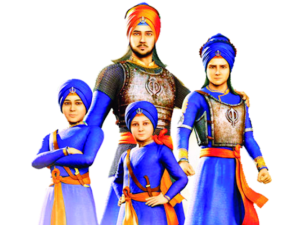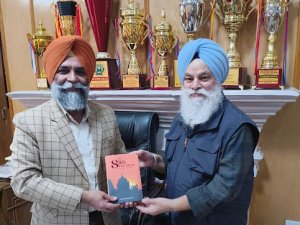Bhai Nand Lal Goya in his poetic tribute to Guru Hargobind Sahib, the sixth Sikh Guru, describes him as the embodiment of divine mercy, light, and knowledge. His name's components are interpreted symbolically, reflecting his attributes and significance. He is praised for his compassion, his role as a teacher, and his ability to uplift the downtrodden. The gist of five Persian couplets by Bhai Nand Lal Goya in Ganjnama , rendered as
“Guru Hargobind epitomized divine grace, wherein even the downtrodden and forsaken found redemption and acceptance in divine courts. His benevolence transcends quantification, akin to the enduring nature of stones, while his eminence mirrors the majesty of the Divine. His essence embodies the boundless mercy of the Divine, surpassing even the loftiest of celestial companions. Renowned as both ascetic and sovereign, he commands the obedience of all, regardless of stature.
His radiance illuminates both terrestrial and celestial realms, with all yearning for the merest glimpse of his grace.”
Birth and Early Life:
Guru Hargobind Sahib, born on June 14, 1595, faced numerous challenges from infancy, including assassination attempts orchestrated by his uncle, Prithi Chand. Despite these plots, Guru Sahib survived poison and snake bites, demonstrating his divine protection. His father, Guru Arjan Sahib, foresaw the need for him to become a "saint-soldier," receiving education and martial training under Baba Buddha Ji and Bhai Gurdas Ji. Guru Hargobind Sahib's physical prowess and spiritual depth were evident, leading Guru Arjan Sahib to bless him before his martyrdom in 1606.
Guru Hargobind Sahib's marriages to Bibi Damodariji, Bibi Nanki, and Bibi Mahadevi yielded prominent children, including Baba Gurditta Ji, Bibi Viro Ji, Baba Atal Ji, and Guru Tegh Bahadur Sahib. Despite adversities, Guru Hargobind Sahib's birth and upbringing exemplify resilience and divine intervention, laying the foundation for his future role as a spiritual and martial leader of the Sikh community.
Declaration of the Sikh Army:
The declaration of the Sikh army marked a significant shift in Sikh ideology and action, prompted by the persecution faced under Emperor Jahangir's reign. Guru Arjan Dev Ji's martyrdom, orchestrated due to political and religious tensions, served as a catalyst for this transformation. Recognizing the need for defensive measures, Guru Arjan Dev Ji instructed his son, Guru Hargobind Sahib, to establish and maintain an army. This directive was rooted in the principle of defending religious beliefs and principles against external threats.
The instigators of Guru Arjan Sahib's persecution included both Hindu Brahmins, represented by figures like Prithi Chand, and influential Muslims, such as Sheikh Ahmed Sarhandi. Their collaboration in conspiring against Guru Sahib underscores the extent of religious and political animosity faced by the Sikh community.
The decision to establish a Sikh army reflected a pragmatic response to the escalating persecution and provided a means to protect Sikh principles and followers. This declaration, symbolized by the unveiling of Akal Takht Sahib, marked a pivotal moment in Sikh history, demonstrating the community's resolve to defend its faith and values against oppression and injustice.
The Significance of Sri AkalTakht Sahib:
A Symbol of Spiritual and Worldly Power established by Guru Hargobind Sahib in 1609, Akal Takht Sahib holds immense significance in Sikh history, serving as a symbol of both spiritual and worldly power. Guru Hargobind Sahib laid the foundation stone with his own hands, marking the beginning of a new era for Sikhism. Guru Sahib embodied the concept of Miri Piri, balancing worldly authority (Miri) and spiritual leadership (Piri), ensuring both were intertwined for the Sikh community. From Akal Takht Sahib, Guru Hargobind Sahib issued edicts, emphasizing the importance of arms and horses for the protection of Sikhism against tyrannical rulers. Guru Sahib trained Sikh warriors in guerilla warfare tactics, forming a formidable army to resist oppression and safeguard religion.
Sangat gathered daily at Akal Takht Sahib, where Dhadis and poets instilled bravery and patriotism among the Sikh warriors. Guru Sahib declared Akal Takht Sahib as a symbol of justice and truth, where religion and politics were subservient to righteousness. Akal Takht Sahib became a political office, facing military challenges and issuing edicts that marked the autonomy of the Sikh community. Despite its significance, Guru Sahib faced opposition and conspiracies from various quarters, leading to confrontations with the Mughal authorities. Guru Hargobind Sahib's establishment of Akal Takht Sahib laid the foundation for a sovereign Sikh nation, showcasing a unique blend of spiritual devotion and martial valor.
Detention in Gwalior Fort:
Guru Hargobind Sahib's detention in Gwalior Fort marked a pivotal moment in Sikh history, prompted by Emperor Jahangir's concerns over his military organization and lifestyle. Historical accounts vary on the duration of his imprisonment, with some suggesting up to six years. Notable figures such as Hazrat Mian Mir and Wazir Khan played roles in securing his eventual release, which occurred on October 26, 1619. His release was conditional, involving the liberation of other prisoners. Following his release, Guru Hargobind Sahib resumed religious and military activities among Sikhs, fostering renewed enthusiasm and unity within the community. The incident also saw shifts in Jahangir's attitudes towards Guru Sahib and those involved in the martyrdom of Guru Arjan Sahib.
Travels:
Guru Hargobind Sahib undertook significant journeys to spread and strengthen the ideology of Guru Nanak Sahib. His travels included visits to Doaba, Kashmir, Gujarat, and Garhwal State. In Doaba, he attracted numerous followers and selected warriors for his army. In Kashmir, he provided aid during a plague outbreak and preached Sikhism, gaining thousands of followers. His journey to Gujarat led to encounters with influential figures like Fakir Daula Shah, expanding the Sikh community. The Garhwal State journey showcased his philosophy of combining spirituality with military prowess, exemplified by his interaction with Sampat Ramdas. Through these journeys, Guru Hargobind Sahib demonstrated a holistic approach to spirituality, societal engagement, and leadership.
Some Significant Narratives:
During the time of Guru Hargobind Sahib, several significant narratives emerged, each reflecting the socio-religious dynamics of the era. One such tale is that of Kaulan, daughter of Qazi Rustam Khan of Lahore, who, despite familial and societal pressures, embraced Sikhism under the influence of Guru Hargobind Sahib's teachings. Her steadfast devotion led to the establishment of Kaulsar, a memorial tank near Darbar Sahib.
Another narrative involves Mai Sulakhni, who, longing for progeny, sought Guru Hargobind Sahib's blessings and was blessed with seven sons, underscoring the belief in the Guru's divine grace.
The valorous deeds of Bhai Bidhi Chand, who courageously retrieved horses forcibly taken by the authorities, exemplify the commitment of Sikhs to justice and righteousness during Guru Hargobind Sahib's time.
Additionally, the poignant account of Baba Atal Rai Ji's brief yet impactful life showcases the ethical teachings of Guru Hargobind Sahib, emphasizing humility and acceptance of natural laws.
Lastly, the tale of Sikh farmer, a poor Sikh, demonstrates the unwavering faith of Sikhs in their Guru, even in the face of material temptations, highlighting the spiritual bond between the Guru and the Sikh community.
These narratives not only enrich Sikh history but also embody timeless lessons of devotion, courage, and righteousness.
Battles:
First Battle - Hargobindpur: On 28 September 1621 AD, Guru Hargobind Sahib faced the first battle at Hargobindpur against Guru Dokhis and Mughal troops. Led by Karam Chand, Bhagwane, and Ratan Chand, the attackers were defeated by the Sikh warriors, with Bhagwan killed and others injured or fleeing.
Second Battle - Ruhila :Four days later, on 3 Katak 1678 B (4 October 1621 AD), the second clash occurred in Ruhila village. Ratan Chand and Karam Chand were slain, along with Sikh martyrs including Bhai Nanu and Mathra Bhat.
Third Battle - Amritsar: In April 1634, near Dhinthali Sahib, Guru Sahib faced Shah Jahan's forces as they sought to reclaim a falcon captured by the Sikhs. This marked the beginning of the first war between Mughals and Sikhs, resulting in the death of Faujdar Murtaza Khan.
Fourth Battle - Maharaj: In December 1634, a 20,000-strong Lahore army led by Lala Beg and Qamar Beg clashed with Guru Hargobind Sahib's forces at Maharaj. The intense battle lasted for two days, leaving casualties on both sides.
Fifth Battle - Kartarpur :On 26-27 April 1635 AD, at Kartarpur, Sikh forces under Guru Hargobind Sahib faced betrayal from Asman Khan and Mukhilas Khan, leading to a fierce battle. Guru Sahib's exceptional swordsmanship, including the defeat of Pande Khan, marked a significant victory despite heavy losses on both sides.
Nissan and Hukmnamas:
Nissan and Hukmanamas hold immense significance within the Sikh community, acting as precious treasures guiding their faith and practices. These edicts, issued by the Sikh Gurus, were revered by the Sangat and played a vital role in maintaining the Guru-Sikh relationship. While many edicts have been lost over time due to various reasons, a few, such as those of Guru Hargobind Sahib, have been preserved, providing invaluable insights into religious, political, and literary history. The edicts of Guru Hargobind Sahib are particularly revered, with only two Nissans and two edicts available to the Khalsa Panth. These edicts, beginning with 'Ik Onkar Guru Sat' or 'Ik Onkar Satguru', contain blessings, names of prominent Sikhs, and instructions. They were received with utmost respect by the Sangat, symbolizing the Guru's guidance and authority.
Gurdwaras:
Gurdwaras associated with Guru Hargobind Sahib hold significant historical and spiritual importance in Sikhism. One prominent example is the Sri Akal Takht Sahib in Amritsar, which was established by Guru Hargobind Sahib as a symbol of political sovereignty and justice. Another notable Gurdwaras scattered in India and Pakistan. These Gurdwaras not only serve as places of worship but also as centers of community service and empowerment, embodying the principles of Sikhism propagated by Guru Hargobind Sahib.
Selfless Sikhs:
The selfless Sikhs of Guru Hargobind Sahib exemplify the principles of Seva (selfless service) and sacrifice in Sikhism. During his leadership, Guru Hargobind Sahib's Sikhs, which were in hundreds actively engaged in charitable deeds, community service, and defending the oppressed. They embodied the ethos of Sarbat da Bhala (welfare of all) by establishing langars (community kitchens) to feed the hungry and providing shelter to the needy. Additionally, they fearlessly stood against injustice and tyranny, exemplified by their willingness to fight alongside their Guru in battles against oppressive forces. Through their actions, these selfless Sikhs demonstrate unwavering devotion to Guru Hargobind Sahib's teachings and the broader Sikh values of compassion, equality, and justice. (Based on my Punjabi research book Teghzan Guru Hargobind Sahib)






